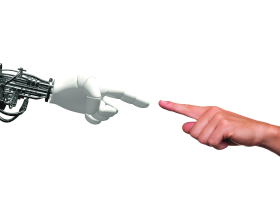

If we look for applications of artificial intelligence (AI) in our daily lives, we can see it in autonomous vehicles, medical applications, search engines, Virtual Assistants, and image recognition. Or can we? It is argued that there is no ‘real’ AI in practice yet, and what we see is just the basics of machine learning (ML), also that it will take many years to create a true AI application.
But let’s unpack exactly how far AI has come and what it potentially can do for society and more importantly, surveillance.
How far has AI come?
Since the term was introduced in 1956, AI technology has gone from being hailed as the key to a bright new future, to a complete failure, to an interesting tool for applications, including surveillance. Since 2015, AI technology – or at least the embryo of it – has become part of our everyday lives and is currently a popular tagline in many applications.
We might be far from a truly ‘intelligent machine’, but AI is already being used in voice recognition and search engines; in healthcare to help identify indicators for cancer; voice translations – although these still have a way to go – and in prototypes for self-driving cars and service robots.
Some people expect AI to eventually become a game-changer in surveillance solutions and it’s easy to understand why. AI systems are able to analyse huge amounts of data, which of course is advantageous when you have to review hours of surveillance images. By ‘learning’ how the observed object moves, how tall or small it is, whether it has two arms and two legs and how fast it is going, the AI application ranks the information and decides whether it is probable that the object is human. This kind of functionality is common in the field of safety and security today.
Artificial intelligence, machine learning and deep learning
AI is the act of simulating an intellectual task. An essential component of AI is ML and sometimes the two expressions are used interchangeably. AI uses algorithms to go through data, learn from it, and then make predictions. However, to mimic the complex human brain a computer needs lots of training. So-called deep learning (DL) is an advanced way of implementing ML, but it requires lots of data, advanced classifications and serval layers of analysis to produce ‘deeper’ knowledge. A compute-intensive model, DL is today mostly run on servers with multiple GPU processors, but when edge devices increase their computing capacity, some applications will probably move there in the future.
AI in surveillance – design with a purpose
A surveillance solution – with or without AI – is rarely an off-the-shelf solution since every business and use case is unique. Understanding the primary purpose of the system and how the footage eventually might be used is essential. Image usability can only be achieved if the system has been adapted to the specific conditions of the environment and is properly maintained.
To succeed, the primary focus therefore can’t be on the technology, but on the solution of a particular use case. Only as part of a complete and well-designed solution, where human expertise has taken all kinds of considerations into account, can AI offer great opportunities within surveillance.
AI in surveillance – advantages
Whenever there is a need to process and analyse huge amounts of data, computers beat humans. A well-trained AI can take this to an even higher level of data and image analysis. This functionality can be of practical use in many applications.
Safety and security – An AI system can, if properly set up and configured, quickly correlate events detected in several hours of video material from several sources. A surveillance system using AI can trigger a direct alarm, where a potential burglar can be ‘told off’ before the crime has even been committed.
Business optimisation and smart cities – Surveillance systems with AI can detect unusual behaviour patterns and use the data to optimise operational efficiency in retail environments or even allow for a controlled flow of traffic and quick responses to incident reports on a highway.
AI in surveillance – challenges
It’s easy to get carried away by the potential of AI in a range of applications, such as improvement of configuration, system optimisation, site design, image configuration and device management. However, there are still fundamental challenges that need to be solved.
Human experience beats AI – An AI application can successfully detect a ‘running person’ but, unlike humans who can put the data into context, it cannot know why that person is running – to catch the bus or because he has just robbed the bank.
Quality of the data – Without ‘raw material’ in terms of high-quality footage and video, an AI system has nothing to analyse. If the cameras can’t handle challenging light or if the angles are wrong, it could jump to the wrong conclusions.
Compute-intensive technology – Memory, processing power, and power consumption are the biggest challenges within AI, especially for deep learning applications. Today’s systems require vast amounts of space to store data for learning, either in the cloud or on a server with multiple GPUs.
AI systems have developed rapidly over the past years and show potential within the field of surveillance, but we are far from having developed human-level intelligence, or ‘true’ AI. It will take some time before we see self-learning surveillance systems that can make accurate assumptions in general scenarios without risking too many false alarms or the violation of people’s integrity.
For more information contact Axis Communications, +27 11 548 6780, [email protected], www.axis.com
| Tel: | +27 11 548 6780 |
| Email: | [email protected] |
| www: | www.axis.com |
| Articles: | More information and articles about Axis Communications SA |

© Technews Publishing (Pty) Ltd. | All Rights Reserved.